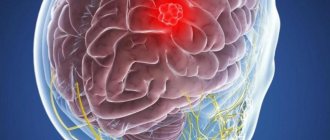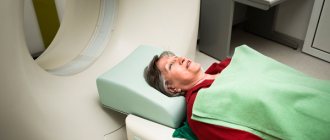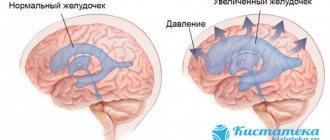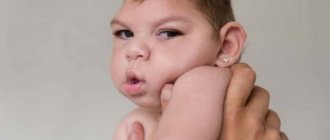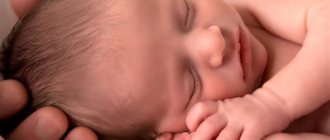To make a correct diagnosis for neurological lesions, the doctor needs to find out the location and nature of the pathological process. But the difficulty of the task is that it is impossible to see the source of damage, since it is located in the brain, so the disease is diagnosed based on clinical signs of a nervous system disorder. These include cerebral syndrome and focal symptoms. Only after comparing the data of all manifestations, the neurologist makes a topical diagnosis, supplementing it with instrumental and laboratory examination methods.
Organic brain damage in children
The concept of “organic brain damage in children”, in fact, does not have a clear definition. However, it is generally accepted that this is a whole complex of ailments associated with structural pathological changes in brain tissue.
They can be
both diffuse (for example, appear as a result of encephalopathy) and localized (arise as a result of a tumor or brain injury)
In such children, the functions of many tissues in the brain and not only are impaired; it takes a lot of time for them to be replaced with others or healthy ones that will perform their functions correctly
IMPORTANT! Children have unique immunity and regeneration, so with any diagnosis you can count on significant improvements if you give the body techniques that help renew tissues
In modern pediatrics, this phenomenon, alas, is not uncommon. The brain of children is subject to a number of negative influences. Moreover, neurologists claim that the diagnosis of “organic brain damage” today can be made in 9 out of 10 patients of any age
It’s just that most of these lesions do not make themselves felt. Symptoms of APM clearly manifest themselves when 20 to 50% of the organ has undergone changes. If the damage has affected more than half of the brain, then it is worth talking about serious signs of the disease that are persistently pathological in nature
But there is another side to the coin. Often, not very qualified specialists simply abuse this diagnosis, not wanting to deeply analyze the nature of the child’s neurological pathology
There is an International Classification of Diseases, X revision, in which organic brain damage is not included. For this reason, doctors formulate a diagnosis associated with such pathologies, as they say, “who knows”: “unspecified brain damage” or “unspecified encephalopathy”
One way or another, in medicine there is a certain classification of ailments that can be combined under the term OBM (organic brain damage)
Diseases related to organic brain lesions
Hydrocephalus Congenital anomalies of brain development Cerebral palsy Cerebral palsy Disorders caused by intrauterine infections (toxoplasmosis, syphilis, cytomegaly, etc.) A group of diseases caused by damage to the central nervous system (CNS)
Diagnostics
The diagnosis of OPGM is carried out by a neuropathologist. After examining the patient, he prescribes the following brain tests:
- CT scan – the functional state of the organ is studied, structural changes are revealed;
- neurosonography – the cerebrospinal fluid spaces are examined and neoplasms are identified;
- REG – vessels are examined;
- Doppler ultrasound is an ultrasound of the brain cavities;
- MRI – structural changes in brain tissue, blood vessels, nerve fibers, and the degree of damage are revealed.
Organic brain damage: causes
To make a diagnosis of APM, a physician must carefully examine a number of factors.
Each ailment included in this group is characterized by many nuances - it has its own nature and develops in a special way. The nature of its treatment largely depends on the cause of the development of the disease.
There are several main causes of organic brain damage in children
1. First of all, it is necessary to carefully analyze the perinatal period, during which the child’s brain was formed. It is at this time that serious pathologies can arise if the expectant mother is sick (she has a heart defect, high blood pressure, diabetes mellitus, anemia, severe toxicosis, etc. .), leads an unhealthy lifestyle, is exposed to stress, experiences toxic effects, etc. Significant changes in the functioning of a child’s brain can be caused by infections, which will be discussed in more detail below.
2. The way the birth took place is also of great importance for the health of the baby. Whether it was rapid or protracted, whether it occurred with hypoxia, with entanglement, whether the child received a birth injury
3. The cause of APM can be hemolytic disease of the newborn (HDN), that is, incompatibility of the blood of mother and child, if it is accompanied by kernicterus. This form of jaundice is characterized by an increased content of indirect bilirubin in the baby’s blood, and this, in turn, provokes dysfunction of the brain brain
4. Mechanical traumatic brain injuries also entail serious damage to brain tissue. They can be either open, that is, when the wound is in contact with the external environment, or closed
5. Organic brain damage is often caused by infectious diseases (meningitis, abscess, encephalitis, etc.), including intrauterine infections that provoke damage to the central nervous system - rubella, herpes, enteric and respiratory viruses, immunodeficiency virus, etc.
6. OPM can also occur as a result of vascular diseases of the brain - encephalopathy, hemorrhagic stroke
7. This kind of pathology can develop from a benign tumor
8. Epilepsy can also provoke organic brain damage in a child
9. APM can also be caused by multiple sclerosis, Parkinson's disease or Alzheimer's disease
10. There is another reason for the occurrence and development of severe brain damage in children, which traditional medicine is silent about. We are talking about post-vaccination complications, as a result of which the children’s brain ceases to form properly. You can read more about the effect of vaccinations on the child’s body HERE
Expert commentary
Discirculatory encephalopathy, or chronic cerebral ischemia, is not an independent disease, but a consequence of poorly controlled arterial hypertension, diabetes mellitus, atherosclerosis of the vessels of the brachiocephalic trunk, atrial fibrillation and a number of other reasons. Therefore, the most important component of treatment is the control of these conditions: correctly selected antihypertensive, hypoglycemic, antiplatelet or anticoagulant therapy, correction of cholesterol levels. Lifestyle modification and smoking cessation are required.
Symptoms of organic brain damage in children
The main sign of organic brain damage in children is psycho-organic syndrome. This condition is expressed in a violation of three aspects of the functioning of the main human organ at once.
1. Problems with memory - the child does not remember new information well and loses some of what has already been learned (partial amnesia). Moreover, with APM, unreal memories may appear
2. Decreased intelligence - such children have difficulty concentrating, their thinking is impaired, and they have difficulty navigating in space
3. Affective disorders and cerebroasthenia - children with organic brain lesions constantly experience weakness, dizziness and headaches, they are susceptible to depression, irritability. Often such children show inappropriate emotions
Dementia is another symptom of organic brain damage, which is characterized by impaired cognitive activity. This condition is not congenital, like mental retardation, but acquired. The functions of a child's damaged brain begin to disintegrate. Sometimes the dementia is so severe that the child cannot learn to care for himself.
There are also a number of focal symptoms , which depend on in which area of the brain the disorders are localized
Frontal lobe – facial and ocular muscles are paralyzed, the sense of smell is impaired and words are difficult to pronounce, difficulty performing purposeful movements, strange behavior on the verge of euphoria
The parietal lobe is a violation of sensitivity, the inability to perform purposeful, meaningful actions, as well as the inability to learn reading and counting. Seizures with convulsions are common
Temporal lobe – impaired sense of smell and hearing, problems with taste, there are hallucinations, emotionally unstable mood, partial or complete misunderstanding of speech
Occipital lobe – visual impairment up to blindness, problems with coordination of movements and balance, hallucinations, convulsions during seizures
Features of pathological disorders in childhood
One of the common causes of neurological disorders in childhood is intrauterine infection. The most severe lesions occur with congenital rubella, cytomegaly, toxoplasma, and syphilis. The consequences that result from infection of the fetus depend not so much on the type of pathogen, but on what month of intrauterine development this infection occurred. If the fetus is infected in the third trimester of pregnancy, the child may be born completely healthy. But already in the neonatal period or a little later, general and focal symptoms of brain damage appear:
- child's restlessness, tearfulness, interrupted night sleep, refusal to eat;
- increased sensitivity to touch, sound, light;
- the appearance of vomiting;
- increase in body temperature within 37.5 – 38°C;
- weight loss;
- increased muscle tone;
- tension of the large fontanelle;
- convulsions.
Other focal symptoms of organic damage: severe convergent or divergent strabismus, facial asymmetry, involuntary oscillatory movements, voice formation and swallowing disorders, muscle weakness, etc. Many children with the consequences of early brain damage exhibit features of dysplasia (impairments in the development of tissues, organs or parts of the body): deformation of the skull, facial skeleton, ears, widely spaced eyes, high palate, abnormal growth of teeth, protruding upper jaw, etc. . Common consequences of early brain damage are cerebrasthenic syndrome, neurosis-like syndrome, hyperactivity syndrome. (A syndrome is a collection of specific symptoms.)
Organic brain damage in children: treatment
Naturally, treatment for APM should be prescribed based on the cause of its occurrence and development. For example, doctors recommend eliminating lesions caused by infection using antibiotics, antiviral drugs and immunostimulants. If APM developed as a result of a tumor, then, first of all, care must be taken to remove it
Official medicine suggests treating ischemic diseases of the brain with nootropic drugs , as well as using decongestant and vascular therapy
See also: Medications for autism: do they make sense?
In almost all cases, doctors strongly advise taking
sleeping pills antidepressants tranquilizers
In parallel with taking medications for brain damage, doctors recommend using non-drug therapy
It is designed to mitigate the side effects of taking heavy chemical drugs.
This
hypnotic effect on the child, auto-training, acupuncture and reflexology, art and gestalt therapy, massage. In Ukraine, Dr. Rakhmanov
the article about books, pay attention to the book about massage by Tatyana Pankratova. It describes a technique for influencing a child through the peripheral nervous system, sound therapy , etc.
See also:
Treatment of autism in children. Autism. Recovery method
Find out more about free recovery programs for autism, cerebral palsy and epilepsy according to the principles of biomed and naturopathy with a diet including natural products Tentorium
Seminar plan HERE Tentorium beekeeping products restore every cell of the body naturally according to the principles of biomedical correction of the bodyThey saturate the body with necessary enzymes, vitamins and microelements. There are also products that will help remove toxins from the body without problems after drug treatment
Disclaimer The information provided in this article is for the reader's information only. It is not intended to be a substitute for advice from a medical professional
Complications of the disease
Encephalopathies of mixed origin have a favorable prognosis only at the compensated stage. Stage 2 disease may result in persistent symptoms, but their severity is much less severe.
With grade 3, deterioration is inevitable - patients acquire complications such as dementia, coronary artery disease, and the risk of stroke and heart attacks increases.
Under the influence of pathological disorders, chronic diseases are significantly aggravated. If the disease progresses, a 1-3 degree disability can be issued, depending on the decision of the medical commission.

